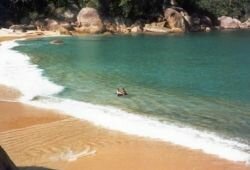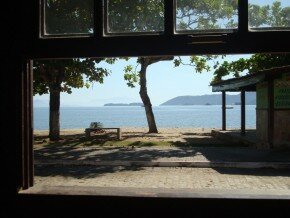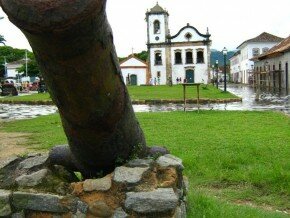-
Information
- Paraty History
- Paraty Gold Road
- Directions to Paraty
- Where to eat in Paraty
- Where to shop in Paraty
- Paraty Nightlife
- Tourist Information
- Paraty Beaches
- Trinidade
- Historic Centre
- Paraty Carnival
- Sugar Cane Fest
- New Year
- Paraty International Literary Festival
- Paraty em Foco
- Paraty Latino International Music Festival
- Bourbon Jazz Festival Paraty
-
 Excursions & Tours
Excursions & Tours
Ecotourism, Adventure Tourism, boat rides and much more! [+ info]
-
 Paraty Beaches
Paraty Beaches
The natives of Paraty said that simply to dive in the waters of the Paraty bays was able to cure any disease. And no wonder! [+ info]
-
 Transfers to and from Rio de Janeiro
Transfers to and from Rio de Janeiro
Book your transfer from the airport to straight to Paraty on line [+ info]
Paraty Gold Road
What is the Gold Road?
Cutting through the States of Minas Gerais and Sao Paulo to the port cities of Paraty and Rio de Janeiro, the Royal Road thrived during the diamond and gold-digging years of the 16th, 17th and 18th centuries, linking many of the most important historic towns in the region. After many decades out of the spotlight, it is now resurfacing as a popular itinerary for those in search of culture, history, typical regional food and a large variety of outdoors activities.
Paraty grew in the 18th century as a strategically important port for exporting the gold mined in Minas Gerais. When shipments in nearby Rio began to attract the attention and ambition of pirates and privateers from rival European powers, the Portuguese began using Paraty as their safe port for getting their gold to Lisbon. Together with Ouro Preto, the town was part of the Royal Road (Caminho Real or Caminho do Ouro, Gold Road), a route used to export gold in colonial times. It was also an obligatory sleep-over stop for travelers between Rio and São Paulo until the late 1800s, when the inner road was opened.

A word of advice
The beginning of the tour is at the Tourist Information Centre Gold Road. There you will find information, maps, photos, a handicraft shop, an exhibitions area, etc. The landscape of the Royal Road outstands in the landscape next to the Igreja de Nossa Senhora da Penha.
Through the Revitalization of the Gold Road Project - In the Trail of History, a joint venture between the Paraty City Hall, the Sebrae RJ and the Paraty Tourism Guides Association, 4 kilometres of the old road were recovered.

A bit of history
Cutting through the States of Minas Gerais and Sao Paulo to the port cities of Paraty and Rio de Janeiro, the Royal Road thrived during the diamond and gold-digging years of the 16th, 17th and 18th centuries, linking many of the most important historic towns in the region. After many decades out of the spotlight, it is now resurfacing as a popular itinerary for those in search of culture, history, typical regional food and a large variety of outdoors activities
.Paraty grew in the 18th century as a strategically important port for exporting the gold mined in Minas Gerais. When shipments in nearby Rio began to attract the attention and ambition of pirates and privateers from rival European powers, the Portuguese began using Paraty as their safe port for getting their gold to Lisbon. Together with Ouro Preto, the town was part of the Royal Road (Caminho Real or Caminho do Ouro, Gold Road), a route used to export gold in colonial times. It was also an obligatory sleep-over stop for travelers between Rio and São Paulo until the late 1800s, when the inner road was opened.
During the Gold Cycle of the 17th and 18th centuries Paraty connected the cities of Rio de Janeiro, São Paulo e Minas Gerais. Paraty also served as a Commercial Outpost and, given its geographical position, as an exit port for the gold of Minas Gerais. It was one of the most important port towns of the 18th century.
Since the discovery of gold in what is today the state of Minas Gerais at the end of the 17th century, the trail reached the village of Falcão (currently Cunha), from where it went down to the Valley of the Paraíba River (Guaratinguetá), continuing on to Vila Rica (currently Ouro Preto). It was the entry road for the slaves and the exit road for the gold. This road went for more than 1.200 kilometres, which usually took about 100 days.
Nature and Environment - The National Park of the Serra Bocaina
Since a part of the road is located in the Serra da Bocaína National Park, visitors can appreciate beautiful natural landscapes, watch specimens of flora and fauna of the Atlantic forest, such as: Flora: Jequitibá, Ipê, Araribá, Cinammon trees, Quaresmeira, Palmito Jussara, Bromeliads, Orchids, etc. Fauna: Sabiá, Tiê, Saíras, Tangará, Tucan, Parrots, Pica-pau, Lizzards, Caxinguelê, Guaxinim, Tatú, Cotias, etc.




